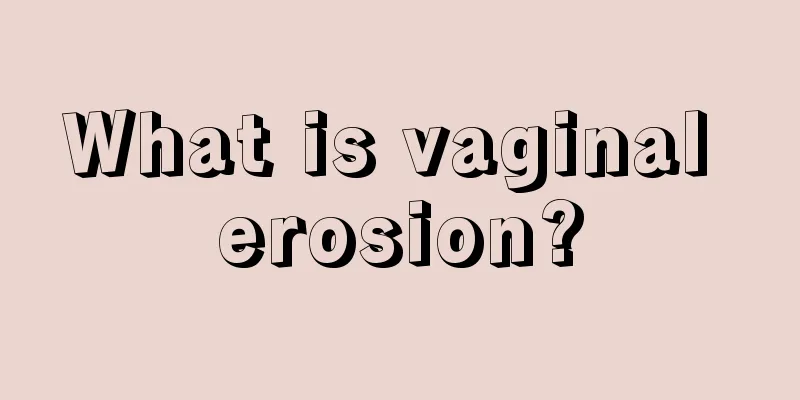Does endocervical effusion need treatment?

|
Endocervical hematoma is a type of cervical disease. Cervical adhesions can be divided into two types: endocervical adhesions and uterine cavity adhesions. Endocervical adhesions refer to adhesions of the cervical mucosa after mechanical damage, resulting in cervical stenosis or occlusion. Cervical hemorrhage is not a minor problem or pain. Once it occurs, you need to go to the hospital for treatment in time. Symptoms of endocervical hemorrhage After suffering from endocervical hemorrhage, women will experience abdominal pain, irregular menstruation, etc., but in most cases they are easy to ignore. There is tenderness in the lower abdomen, and rebound pain or even refusal to press in severe cases. This is an important symptom of patients with endocervical hemorrhage. Generally, gynecological examinations can show that the patient's uterus is normal in size or slightly larger and too soft, but there is obvious tenderness. During bilateral adnexal examinations, patients with severe endocervical hemorrhage will experience tenderness or thickening, or palpable lumps. Regular abdominal pain is another symptom of cervical hemorrhage, which often occurs in women after abortion or curettage. In addition, obvious abdominal pain is a common symptom of women suffering from cervical hemorrhage, so once women experience abdominal pain, they must seek medical attention as soon as possible. Multiple abortions or curettage are a major cause of endocervical hemorrhage in women. What are the symptoms of endocervical hemorrhage? Some women will experience amenorrhea, dysmenorrhea, oligomenorrhea, and secondary infertility after the disease. What is endocervical hemorrhage? For women with complete adhesions in the uterine cavity, long-term amenorrhea may occur; women with partial adhesions in the uterine cavity and/or partial destruction of the endometrium will experience oligomenorrhea. Symptoms 1. Abdominal pain: There will be pain in the lower abdomen, but the level varies, some are moderate and some are mild. Most are potential discomforts. 2. Menstrual irregularities: The common manifestations are excessive menstrual flow or a significant increase in the frequency of menstruation. 3. Infertility caused by cervical hematoma: The bilateral fallopian tubes are affected to a certain extent by the symptoms, which further leads to the obstruction of the bilateral fallopian tubes and causes infertility. 4. Menstrual cramps: The closer to your menstrual period, the more severe the pain will be. You should understand the menstrual cramps during your menstrual period. 5. Others: such as pain during sexual intercourse, excessive leucorrhea, gastrointestinal obstruction, etc. Treatment 1. Use an enlargement rod to expand the vagina and then insert an IUD. However, this type of endocervical hemorrhage surgery is blind and cannot restore the original shape of the uterine cavity, and the incidence of re-adhesion is high. 2. Hysteroscopy integrates diagnosis and treatment. Some difficult-to-solve endocervical hematomas can be handled in an intuitive, simple and safe manner. Membranous adhesions and fibromuscular adhesions can be separated under hysteroscopy or removed surgically; for connective tissue-like high-density adhesions, electrosurgical resection is required under B-ultrasound or laparoscopic monitoring. After the surgery for endocervical hemorrhage, an IUD or protein glue is placed to prevent re-adhesion, so that the patient can restore menarche and achieve the goal of pregnancy. Hysteroscopy and laparoscopy are minimally invasive surgeries that are better treatments for uterine fibroids, ovarian cysts, ectopic pregnancy, etc. Their advantages are not only reflected in the technology, but also in the care of the patient's psychological state. The Gynecological Minimally Invasive Endoscopy Center of Beijing Aobei Hospital has the world's top French [Ande WOLF] hysteroscopy and laparoscopic gynecological minimally invasive surgery diagnosis and treatment technology and equipment, as well as an experienced and highly skilled team of endoscopy experts, which can efficiently treat a variety of serious and major gynecological diseases. |
<<: Will the cervix close after separation?
>>: Does cervical effusion affect pregnancy?
Recommend
How to prevent blue light damage when looking at the screen for a long time
Every day, whether we are working or having fun, ...
How to grow black tea in potted plants? Can black tea be propagated by layering?
Black Bone Tea, also known as Black Bone Tea, is ...
A spring self-help guide for those suffering from allergies: How to deal with pollen allergies?
March is a good time to go out and enjoy the flow...
Low grade CIN lesions HPV positive
When women develop HPV, it has a lot to do with t...
How many months does the fetus have?
After the sperm and egg combine, the fetus slowly...
Chronic pelvic inflammatory disease leucorrhea pictures
Due to their physiological structure, female frie...
What should girls eat at night without gaining weight
Losing weight is a topic that people often talk a...
Can I have an abortion if I am more than one month pregnant?
Pregnancy is a process, and it takes a certain am...
Women drink water to replenish blood and nourish the skin
Many women are very prone to anemia, which is rel...
Is it necessary to do a biopsy if the TCT is normal?
With the emergence of various diseases and the in...
What are the causes of vaginal bleeding in pregnant women?
After becoming pregnant, a pregnant woman will no...
What are the things to pay attention to during the confinement period after miscarriage?
In fact, abortion can cause great harm to women&#...
How to breastfeed with flat nipples
Women need to breastfeed their babies after givin...
Vulva swelling after childbirth
Many mothers are actually very worried about givi...
Why did Chen Yunru commit suicide in the Taiwanese drama "I Want to See You"?
As the Taiwanese drama "Want to See You"...









